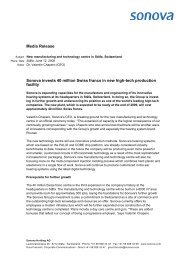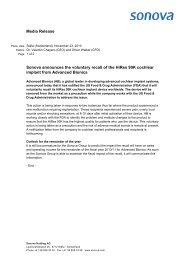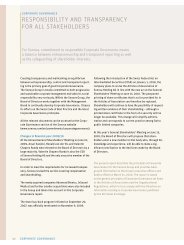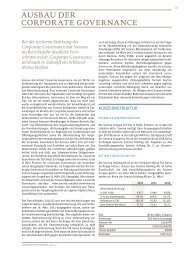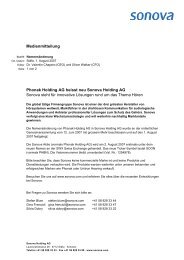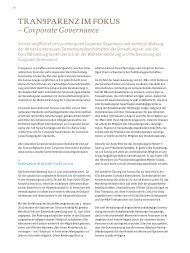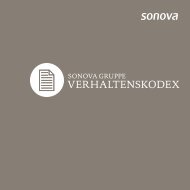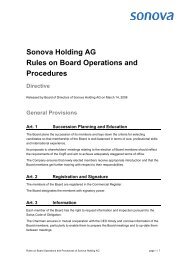Annual Report 2010/11 - Sonova
Annual Report 2010/11 - Sonova
Annual Report 2010/11 - Sonova
Create successful ePaper yourself
Turn your PDF publications into a flip-book with our unique Google optimized e-Paper software.
66<br />
The amount of compensation received by the members<br />
of the Management Board is also reviewed every year. Comparable<br />
companies similar in size and structure or<br />
working in the healthcare industry equally serve as benchmarks.<br />
Several studies of top-level executives and<br />
corporate headquarters that show the compensation of<br />
relevant management positions are used as a basis.<br />
Compensation benchmarks that compare Swiss companies<br />
with a similar size and structure from industries such<br />
as pharmaceuticals, chemicals, and medical technology<br />
are used as a basis to define compensation for the<br />
Board of Directors.<br />
Compensation elements<br />
Three elements are relevant for <strong>Sonova</strong>: a fixed base salary,<br />
a variable compensation component that revolves around<br />
the respective financial year, and, for selected executive<br />
managers and employees, a long-term variable compensation<br />
component.<br />
fixed salary component<br />
The fixed base salary gives each employee a regular and<br />
predictable salary that does not depend on the development<br />
of the <strong>Sonova</strong> Group’s business. The salary level is<br />
based on the functional profile, the market situation,<br />
and the employee’s skills. In its turn, salary progression<br />
depends primarily on the employee’s individual performance,<br />
the market value, and the economic climate.<br />
Variable salary component<br />
The variable salary is an integral element of the target<br />
income. The split between the fixed and variable salary components<br />
is a function of the job profile and respective management<br />
level. The targets for achieving the variable salary<br />
TOTAL rEMunErATIOn MODEL<br />
reward elements Base salary Variable compensation<br />
Def: base pay & allowances<br />
that depend upon the job level<br />
and the job market and are<br />
paid out regularly<br />
Target cash compensation<br />
Total compensation<br />
Target remuneration<br />
Def: variable compensation<br />
depending upon the personal,<br />
team and company performance<br />
component are mutually defined and agreed upon in consultation<br />
with the employees at the beginning of the financial<br />
year. The variable salary component is generally 10% of the<br />
target salary for employees and 10–30% for managers. If<br />
the employee actually reaches less than 80% of the stipulated<br />
target, no variable salary component is paid out. If<br />
the targets are exceeded, the variable salary component may<br />
be a maximum of double the original amount. The amount<br />
paid out depends on the employee’s actual achievement of<br />
objectives by the end of the financial year and also on the<br />
overall performance of the <strong>Sonova</strong> Group or the respective<br />
unit.<br />
Executive Equity Award Plan<br />
The Executive Equity Award Plan (EEAP) serves as a longterm<br />
incentive and is offered annually to the Board of<br />
Directors, the Management Board, as well as other management<br />
levels of the <strong>Sonova</strong> Group. A total of approximately<br />
400 people are participating in the 20<strong>11</strong> plan. The<br />
plan entitles them to receive shares, options, warrants,<br />
warrant appreciation rights (WArs), and/or restricted<br />
share units (rSus). The number of shares, options,<br />
warrants, WArs, and rSus granted varies depending on<br />
the respective management level and on individual<br />
performance. The shares, options, warrants, WArs, and<br />
rSus granted as part of the EEAP are split into four<br />
equal tranches. The options, warrants, and WArs have<br />
terms of five years. Each tranche vests each year,<br />
starting one year after the grant date. The strike price<br />
on which the options, warrants, and WArs are based<br />
corresponds to the closing price for the shares on the<br />
Swiss stock exchange (SIX Swiss Exchange) on the<br />
date on which the options, warrants, and WArs were granted.<br />
The fair value of the options, warrants, and WArs is<br />
calculated on the grant date using an option pricing model.<br />
Long-term Incentives Benefits<br />
Def: variable components as<br />
blocked cash/equity<br />
Def: mandatory and voluntary<br />
benefits granted by the<br />
employer




